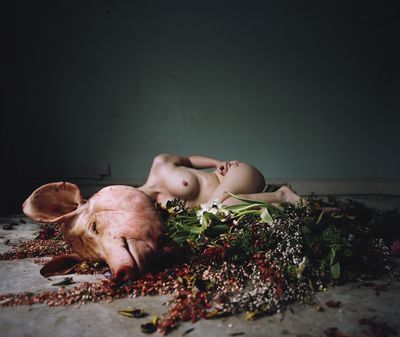“The art of dining well is no slight art . . . ”
By Thea Lenarduzzi
After confronting death, few things can be as life affirming as a good meal, and to take it in the stately setting of Sutton House, East London, is especially invigorating. The house was built in 1535 for Sir Ralph Sadleir – protégé of Thomas Cromwell (the relationship is portrayed by Hilary Mantel in Wolf Hall) and Principal Secretary to Henry VIII – who reputedly held lavish banquets to entertain his fellow courtiers.
Last night we dined in the spirit of Sir Ralph as part of a collaboration between the Horsebox Gallery and the Art of Fine Dining, which brought together new art works inspired by the Vanitas tradition and the excesses of courtly life:
In court to serve decked with fresh array,
Of sug'red meats feeling the sweet repast:
The life in banquets, and sundry kinds of play,
Amid the press of lordly looks to waste,
Hath with it join'd oft times such bitter taste.
That who so joys such kind of life to hold,
In prison joys fett'red with chains of gold.
Thus the ghost of Sir Thomas Wyatt, an ambassador for Henry VIII, albeit between incarcerations in the Tower, may not have been too far from Sir Ralph’s Great Chamber. Channelling him, we “cloak[ed our] care but under sport and play”, gathered around a centrepiece of wilted flowers, burning candles and a skull – designed by Alice Hodge, lest we forget the abyss that awaits us all – and began
to eat . . . .
First came roast quail, to be dismembered and ripped from the bone with our fingers. Next, was crab butter in a wooden bowl (or a bolle of tre), with a white, round loaf. As small as the palm of one’s hand, it would have been known to Sir Ralph and his guests as a manchet, the first recipe for which appeared in The Good Huswifes Handmaide in 1588. Bread of the wealthy, it was made using only the finest, twice-sifted ingredients.
“Tell me what you eat, and I will tell you what you are”, intoned Anthelme Brillat-Savarin some 200 years later, which made the fourth course – bollito misto of cotechino, brisket and ox tongue – sit uneasy. But it was a welcome variation on the Tudor cockyntryche, a pièce de résistance made by stapling together the parts of different animals – generally a large capon and a pig – to create a beast worthy of Dr Frankenstein, only tastier. (Recipe here, for those expecting guests this weekend.)
“Delphine’s Call” by the photographer Sophia Schorr-Kon hung in the room next door.
Waiting for the bus home at the end of the night, I put together Montaigne, Wyatt and Brillat-Savarin and came up with Miss Piggy: “Never eat more than you can lift.”
Peter Stothard's Blog
- Peter Stothard's profile
- 30 followers




